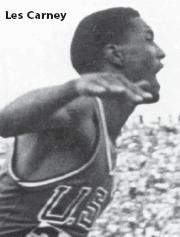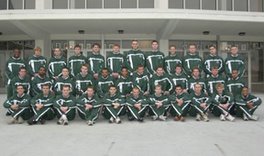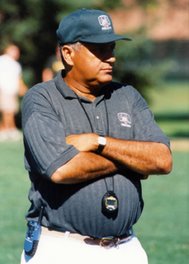Bobcats cut four athletic programs
Ohio drops teams to balance budget, create gender equity
Eliminating four varsity sports will save Ohio University $685,000 annually, begin chipping away at an athletic department deficit that will surpass $4 million after the fiscal year and bring the school into compliance with Title IX federal legislation that guarantees students equal opportunities regardless of gender.
Dollars and cents were far from the only issue yesterday when it was announced that indoor and outdoor men's track, men's swimming and women's lacrosse would be discontinued after the school year. University president Roderick McDavis fought back tears during a news conference. As an undergraduate at the university in the 1960s, he was a member of the track team.
The emotions of athletes in attendance ranged widely. Some wore blank stares, some fought to keep their anger and frustration in check and many on the lacrosse team wept.
"This is one of the toughest things I've ever had to do," said athletic director Kirby Hocutt, who has been on the job for 17 months. "We have no choice. This is significant because if affects the lives of people. This also is an important day in the history of the athletic program. There's still very much to be done."
The cuts were deemed necessary for the department's long-term health. Ohio has been spreading itself thin, fielding the second-largest athletic program in the Mid-American Conference and the 39th-largest nationally with 20 teams. It ranks 105th out of 118 Division I-A universities in average expenses per sport.
"Our athletes have been getting shortchanged," Hocutt said. "For example, the NCAA allows men's track and field teams and swimming teams to have as many as six coaches each. We have three coaches for each of those teams."
Hocutt said the cuts would be the first step in attempting to balance the athletic department's budget by 2011. He said a shortfall of $10 million was projected by 2010 if action weren't taken.
An independent consultant and an advisory group composed of a trustee, a former trustee, two former student-athletes, a dean and the vice president of university finance studied data.
The consultant discovered what athletic department officials had feared: Ohio wasn't compliant with Title IX. To avoid government action and/or a potential lawsuit by an athlete or group of athletes, male athletes had to be pared.
Swimming and diving coach Greg Werner and track and field coach Clay Calkin have been asked to continue coaching the women's teams at their current salaries. Lacrosse coach Allison Valentino's contract will end after the school year.
Not counting seniors, the cuts will affect 87 athletes. Currently, 49 of the underclassmen receive financial aid: 23 in lacrosse, 16 in track and 10 in swimming. They will continue to receive aid for the duration of their athletic eligibility. High school athletes who have signed national letters of intent also will receive aid.
Athletes who transfer to another college will be granted their release by Ohio so they can play immediately. That enticement could determine whether the lacrosse team will have enough players to start the season Feb. 16.
Valentino is counting on playing.
"I'm focused on the present and on our team of 26 players," Valentino said. "As of now, yes, we're going to play. We're in discussions (as a team). My team is dealing with the shock."
Kelley Windle, a junior lacrosse player from Worthington Kilbourne, will remain at Ohio to complete work on a degree in physical education.
"This is all a big shock to us," Windle said. "But when we heard what was happening to the track team, we started putting two and two together. This is tough for a lot of our players. A lot of them are from the East Coast. They came here to play lacrosse. Now, they have to make a choice. It's a bitter feeling."
Swimmer Cy Moser, a junior from Parkersburg, W.Va., is weighing many issues. He wants to continue swimming but has a financial aid package in place at Ohio. He also has signed a year lease with friends on a house for 2007-08.
"I've been swimming since I was 8 years old, and it's a big part of my life," Moser said. "My swimming teammates also are my friends. All of us have a whole lot of thinking to do after the season."
Moser can't understand why swimming was cut. Hocutt said doing away with football, men's and women's basketball, volleyball, softball and baseball wasn't considered.
"The athletic budget is more than $14 million and the swimming budget is only $62,000," Moser said. "We're not a big part of the budget. This is an insult."
Eric Bildstein, a senior from North Olmsted, said the track team would shine through the gloom in the spring. He throws the discus, hammer and javelin.
"We'll take it full-go," he said. "We have one of the strongest programs, and we'll show what we can do. We'll have to swallow this and move on."
Memo: A closer look
The four sports that will be cut at Ohio University after this school year, with the year they became varsity sports at the school:
Men's outdoor track -- early 1900s
Men's indoor track -- 1973 (first year of NCAA championship)
Men's swimming and diving -- 1935
Women's lacrosse -- late 1960s through 1982; reinstated in 1999
Source: Ohio University
* * * *
Recent MAC cuts
Sports that have been cut at other Mid-American Conference schools since 1999:
MIAMI UNIVERSITY (1999)
Men's indoor track
Men's soccer
Men's tennis
Wrestling
EASTERN MICHIGAN (2000)
Men's soccer
Men's tennis
NORTHERN ILLINOIS (2001)
Men's swimming and diving
Women's swimming and diving
BOWLING GREEN (2002)
Men's indoor track
Men's outdoor track
Men's swimming and diving
Men's tennis
TOLEDO (2003)
Men's indoor track
Men's outdoor track
Men's swimming and diving
BALL STATE (2004)
Men's cross country
Men's indoor track
Men's outdoor track
WESTERN MICHIGAN (2004)
Men's cross country
Men's indoor track
Men's outdoor track
Women's synchronized swimming
Saturday, January 27, 2007
Subscribe to:
Post Comments (Atom)




















No comments:
Post a Comment